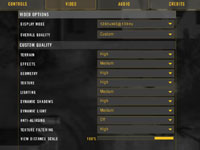
Battlefield 2
Publisher: Electronic ArtsBattlefield 2 features an all-new game engine based on the DirectX 9.0 API. There is no Shader Model 3.0 support, but the majority of hardware will use a Shader Model 2.0++ mode that includes support for Normal Maps, Parallax Mapping, Full-Resolution Dynamic Shadowing, Post Processing and Fog.
The game will look the same on both NVIDIA and ATI hardware, so there is no advantage of choosing one over the other in image quality related circumstances. The only major difference is that Ultra Shadow 2 is utilised on NVIDIA's hardware, while the shadowing on ATI hardware is done using a slightly different technique.
We patched the game to version 1.22 and then played three five-minute segments of the 'Strike at Karkand' map, reporting the median frame rate. We found that there was no ready way to duplicate testing situations manually in this game, so we felt that taking a typical slice of action from the game was the best way to report our findings. We controlled Anti Aliasing from inside the game, while Anisotropic Filtering was set to 8xAF when the 'Texture Filtering' option was set to 'High'.


The GeForce 7900 GTX SLI configuration was not fast enough to achieve smooth gameplay with SLI8xAA enabled at 1920x1200, as the minimum frame rate dropped into the low 20's. In an online battle, the last thing you want is the minimum frame rate dropping into the low 20's - we felt that the extra smoothness from lowering the detail to 4xTSS was beneficial to the overall gaming experience.


The GeForce 7900 GX2 Quad SLI system was able to maintain smooth gameplay at 4xTSS AA 8xAF with maximum in-game details at 2560x1600. Gameplay was very smooth and suitably impressive at these settings and the 7900 GX2s were not far off being super-smooth at an eye-watering SLI8xAA with transparency supersampling enabled. At these settings, we were able to achieve an average frame rate of just over 56 fps and a minimum of 33. We felt that the added smoothness from dropping down to 4xAA was worth it, in all honesty. It's also worth noting that we didn't experience any crashes in Battlefield 2 on the Quad SLI system using the 87.25 driver.

MSI MPG Velox 100R Chassis Review
October 14 2021 | 15:04









Want to comment? Please log in.